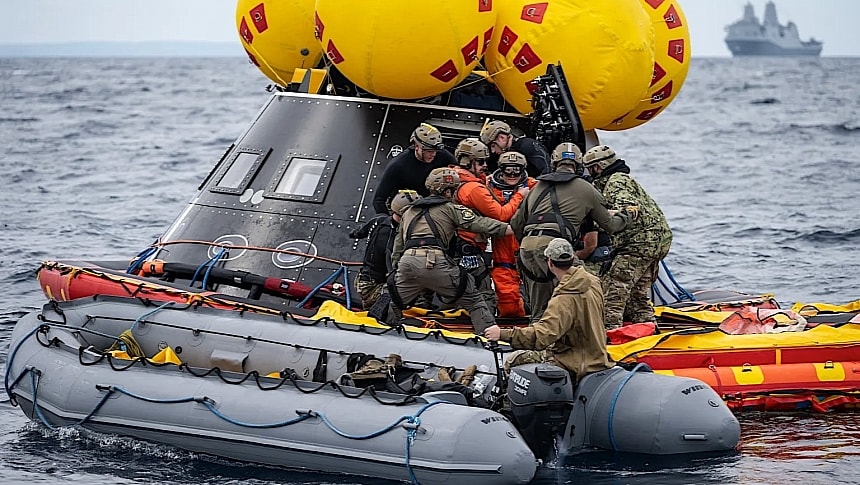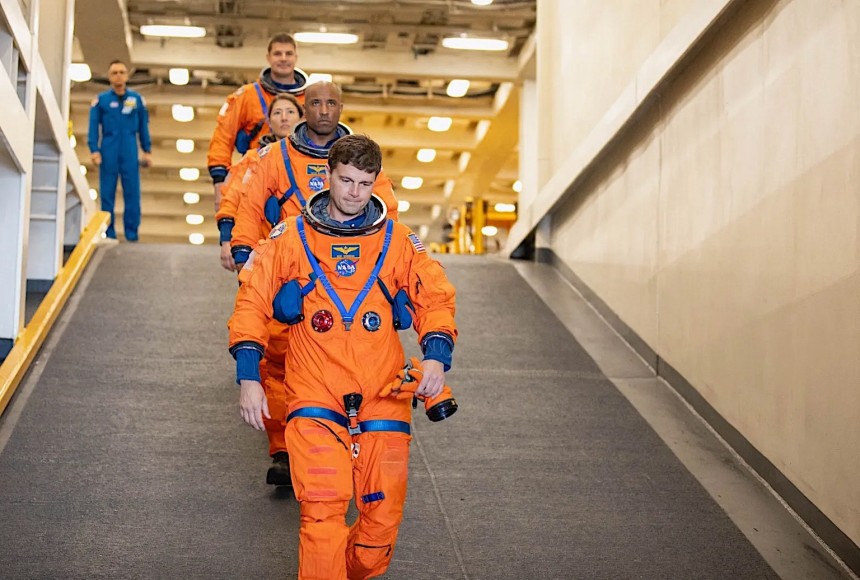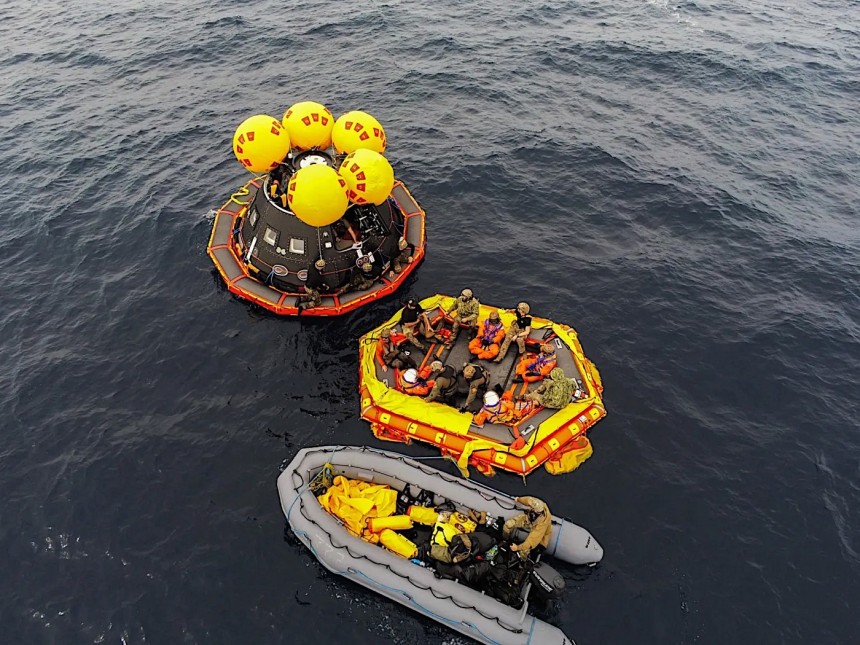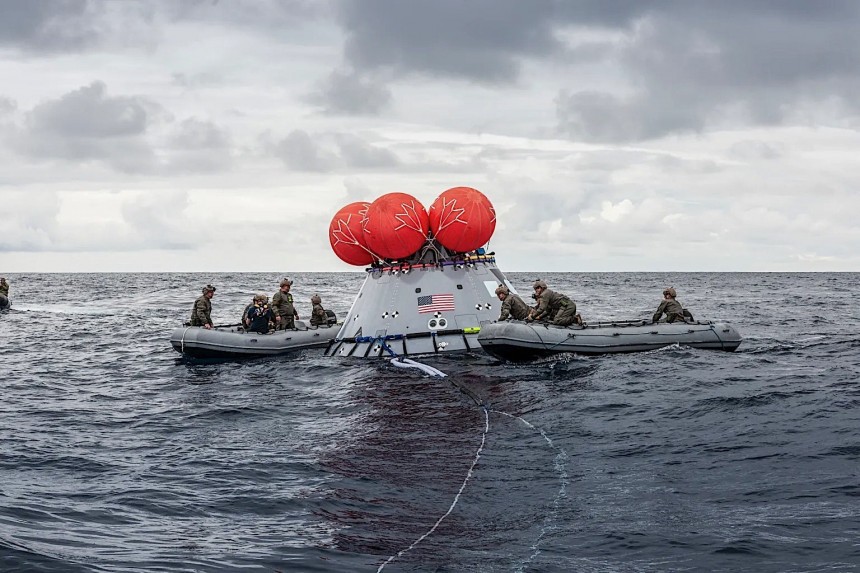The Artemis II mission to the Moon will be the first crewed one of the new lunar exploration program. After the delay announced at the beginning of the year, it is now scheduled to lift off sometime in 2025, and it will be followed a year later by Artemis III, a mission whose crew will actually land on the Moon.
Many of the Artemis II mission details are already known. The hardware that will take the astronauts to the Moon comprises the Space Launch System (SLS) rocket and the Orion capsule, which will take off from Launch Complex 39B at NASA's Kennedy Space Center in Florida.
The crew is made up of four people, including the first person of color, the first Canadian, and the first woman to travel to the Moon: Reid Wiseman (commander), Victor Glover (pilot), Christina Koch (mission specialist), and Jeremy Hansen (mission specialist).
After liftoff, the Orion spaceship carrying these four brave souls will spend two days orbiting Earth in relatively close proximity as the systems are tested and a lunar targeting demo is performed.
The next four days of the mission will be spent approaching the Moon, but also circumventing it and going to a distance of about 230,000 miles (370,000 km) beyond the far side. That would effectively send these four into the history books as the humans who traveled the farthest from our planet to that date.
And then the trip home will begin, covering the remaining time to the estimated 10-day total duration of the mission. Like many others before them, the astronauts will splash down in their spacecraft 60 miles (97 km) off the coast of San Diego, in the Pacific Ocean. They will be intercepted and rescued by NASA and military teams that are already hard at work practicing what they're going to do out there.
And that brings us to our topic today. Although the recovery mission is insanely complex, NASA decided at the end of February to give us the short version of how these efforts will unfold.
First up, who will take part. NASA says the astronaut recovery mission will be a joint effort between the space agency and the Department of Defense (DoD), which is the natural way of things. On NASA's behalf, the heavy lifting falls on the people from the Exploration Ground Systems Program.
The DoD will, naturally, be on the water with Navy ships, but it's unclear at this point exactly which vessel will assist with the recovery. During the mission to retrieve the Orion of Artemis I the USS Portland (LPD 27) was used, while two test runs for Artemis II were performed with the USS San Diego (LPD 22).
But we're here to see how this whole process is going to go, so let's get into it.
As it returns from space, the Orion will approach our planet fast. The spaceship starts braking hard as soon as it enters the atmosphere, by essentially rubbing itself against it as it descends, slowing from a top speed of 25,000 mph (40,233 kph) to just 300 mph (483 kph).
Once that happens a total of 11 parachutes will activate in a set sequence, helping the ship slow down even further, to just 20 mph (32 kph).
That's what we'll all probably see and experience on TV, but work behind the scenes will be a lot more intense, especially given how the splashdown, an apparently clean operation, will leave quite a mess in its wake.
On its way down, the Orion capsule will get rid of the forward bay cover, drogue parachutes, and mortars, and all these items will have to be located as they come down. The task of learning where they will fall rests on the shoulders of a NASA team at the Johnson Space Center in Houston.
The team is named Sasquatch after the software it uses to map where Orion hardware will drop. This is a very important step of the mission because it will allow the ships in the area to steer clear of potential dangers.
Once the detached hardware is out of the way and the capsule itself is on the water, helicopters carrying Navy divers will move to intercept. If everything around the capsule is clear (meaning there is no debris or other dangers), divers will drop into the water and stabilize the Orion.
Once the capsule's hatch is removed, the astronauts inside will climb out and step into the open, supported by an inflatable collar installed by the divers. The Navy people will also inflate a raft, which they aptly call the front porch, and fit it under the hatch.
When the entire crew is clear of the capsule, the front porch will be moved some 100 yards (91 meters) from the capsule and each astronaut will be lifted into one of the two helicopters dedicated to them. The aircraft will transport them in pairs of two to the ship, where they will be medically evaluated.
If all is clear, they will once again board helicopters and they will be moved ashore, and from there they will be transported through unspecified means to the Johnson Space Center. The agency expects the procedure from splashdown to medical evaluation to not last longer than two hours, even if the Artemis II crew arrives at night.
As for the capsule, it too will be recovered and towed into the well deck of the ship that will be on location. Once there, the Orion will be positioned and then secured by means of a winch, ropes, and connection points on top of a stand. The Orion will eventually arrive at Naval Base San Diego, where NASA technicians will really begin tearing into it.
And that's about it. Although simple on paper, the procedure requires a lot of coordination, and for the astronauts on board it might just be harder to endure than the trip to the Moon and back.
The crew is made up of four people, including the first person of color, the first Canadian, and the first woman to travel to the Moon: Reid Wiseman (commander), Victor Glover (pilot), Christina Koch (mission specialist), and Jeremy Hansen (mission specialist).
After liftoff, the Orion spaceship carrying these four brave souls will spend two days orbiting Earth in relatively close proximity as the systems are tested and a lunar targeting demo is performed.
The next four days of the mission will be spent approaching the Moon, but also circumventing it and going to a distance of about 230,000 miles (370,000 km) beyond the far side. That would effectively send these four into the history books as the humans who traveled the farthest from our planet to that date.
And then the trip home will begin, covering the remaining time to the estimated 10-day total duration of the mission. Like many others before them, the astronauts will splash down in their spacecraft 60 miles (97 km) off the coast of San Diego, in the Pacific Ocean. They will be intercepted and rescued by NASA and military teams that are already hard at work practicing what they're going to do out there.
First up, who will take part. NASA says the astronaut recovery mission will be a joint effort between the space agency and the Department of Defense (DoD), which is the natural way of things. On NASA's behalf, the heavy lifting falls on the people from the Exploration Ground Systems Program.
The DoD will, naturally, be on the water with Navy ships, but it's unclear at this point exactly which vessel will assist with the recovery. During the mission to retrieve the Orion of Artemis I the USS Portland (LPD 27) was used, while two test runs for Artemis II were performed with the USS San Diego (LPD 22).
But we're here to see how this whole process is going to go, so let's get into it.
As it returns from space, the Orion will approach our planet fast. The spaceship starts braking hard as soon as it enters the atmosphere, by essentially rubbing itself against it as it descends, slowing from a top speed of 25,000 mph (40,233 kph) to just 300 mph (483 kph).
Once that happens a total of 11 parachutes will activate in a set sequence, helping the ship slow down even further, to just 20 mph (32 kph).
On its way down, the Orion capsule will get rid of the forward bay cover, drogue parachutes, and mortars, and all these items will have to be located as they come down. The task of learning where they will fall rests on the shoulders of a NASA team at the Johnson Space Center in Houston.
The team is named Sasquatch after the software it uses to map where Orion hardware will drop. This is a very important step of the mission because it will allow the ships in the area to steer clear of potential dangers.
Once the detached hardware is out of the way and the capsule itself is on the water, helicopters carrying Navy divers will move to intercept. If everything around the capsule is clear (meaning there is no debris or other dangers), divers will drop into the water and stabilize the Orion.
Once the capsule's hatch is removed, the astronauts inside will climb out and step into the open, supported by an inflatable collar installed by the divers. The Navy people will also inflate a raft, which they aptly call the front porch, and fit it under the hatch.
If all is clear, they will once again board helicopters and they will be moved ashore, and from there they will be transported through unspecified means to the Johnson Space Center. The agency expects the procedure from splashdown to medical evaluation to not last longer than two hours, even if the Artemis II crew arrives at night.
As for the capsule, it too will be recovered and towed into the well deck of the ship that will be on location. Once there, the Orion will be positioned and then secured by means of a winch, ropes, and connection points on top of a stand. The Orion will eventually arrive at Naval Base San Diego, where NASA technicians will really begin tearing into it.
And that's about it. Although simple on paper, the procedure requires a lot of coordination, and for the astronauts on board it might just be harder to endure than the trip to the Moon and back.
















